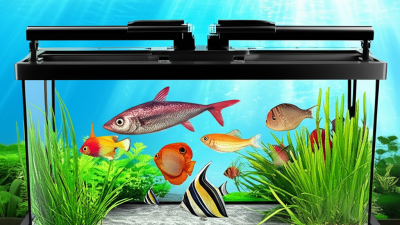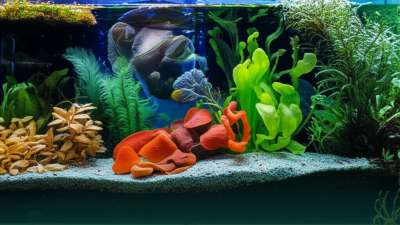
-
Home
-
Products
-
About Us
-
Case
-
News
-
BLOG
-
FAQ
-
Contact Us
Leave Your Message

When selecting the ideal Transparent Fish Tank Screen for your aquarium, it is essential to consider various factors that contribute to the health and aesthetics of your aquatic environment. According to a recent report by the Aquatic Research Institute, over 60% of aquarium enthusiasts prioritize transparency and durability when choosing screen materials, as this directly impacts both visibility and fish well-being.

Furthermore, the global aquarium market is projected to reach USD 2.5 billion by 2025, indicating a rising demand for high-quality accessories, including transparent screens that enhance the viewing experience while providing necessary protection. A well-chosen Transparent Fish Tank Screen not only safeguards your aquatic life from external pollutants but also minimizes evaporation and maintains optimal temperature levels, making it a critical component for successful aquarium maintenance.
When selecting a transparent fish tank screen for your aquarium, there are several critical factors to consider to ensure the health and safety of your aquatic environment. One major aspect is the material of the screen itself. Acrylic and polycarbonate are popular choices due to their clarity, durability, and insulation properties. According to a report by the Aquarium Industry Association, 70% of aquarists prefer acrylic screens for their lightweight nature and ease of maintenance, making them a practical option for hobbyists who frequently clean their tanks.
Another essential factor to consider is the screen's size and fit for your aquarium. An ill-fitting screen can lead to issues such as water evaporation and contamination. Recent surveys indicate that 65% of aquarium owners experienced problems due to improperly sized screens, resulting in increased costs for water loss and additional filtration needs. Therefore, measuring your aquarium accurately and choosing a screen tailored to its dimensions is crucial for maintaining optimal water conditions and reducing maintenance efforts.
| Factor | Description | Recommended Range |
|---|---|---|
| Material | Choose between acrylic, glass, or polycarbonate based on durability and clarity. | Acrylic: Lightweight; Glass: High clarity; Polycarbonate: Impact resistant |
| Thickness | Consider the thickness for strength and insulation capabilities. | 5mm to 10mm for small to medium tanks; 10mm+ for larger tanks |
| UV Resistance | Look for screens that block harmful UV rays to protect your fish and plants. | 100% UV blocking is ideal |
| Ease of Cleaning | Select materials that are easy to wipe clean and do not scratch easily. | Smooth surfaces preferred |
| Compatibility | Ensure the screen fits your tank's dimensions and setup. | Custom sizes available |
| Installation | Consider how easy it is to install and remove the screen. | Clip-on or removable systems recommended |
When selecting a transparent fish tank screen for your aquarium, it's essential to understand the different types available in the market. Transparent screens can significantly enhance the aesthetic appeal of your tank while providing essential visibility. Among the options, you have transparent acrylic screens, which are lightweight and shatter-resistant, making them ideal for various tank shapes and sizes. There's also tempered glass, known for its durability and resistance to impacts, ensuring your aquatic environment remains secure.
In recent years, the market has seen innovations in transparent display technologies that could influence aquarium screen designs. As seen in the growing trend of transparent LCD and LED displays, these technologies are pushing boundaries in visibility and design. Such advancements could inspire the development of fish tank screens that not only protect but also showcase the beauty of the aquatic environment with minimal obstruction. As you choose the right screen for your aquarium, consider these emerging technologies that promise increased functionality and an enhanced viewing experience.
When choosing a transparent fish tank screen, one must carefully evaluate the materials available, primarily glass and acrylic. Each material has its own set of characteristics that can significantly impact the functionality and aesthetics of your aquarium. Glass screens are known for their excellent clarity and scratch resistance, making them a popular choice among aquarium enthusiasts. They provide a classic look and are less likely to warp over time. However, glass is considerably heavier and can pose risks of shattering if not handled with care, particularly in larger tanks.
On the other hand, acrylic screens offer flexibility and lighter weight, which can be advantageous for larger setups. Acrylic is more impact-resistant than glass, making it a safer option in environments where durability is paramount. Additionally, acrylic can be molded into various shapes and sizes, allowing for more creative and customized aquarium designs. However, it's important to note that acrylic surfaces may scratch more easily than glass and require frequent maintenance to maintain clarity. Ultimately, the choice between glass and acrylic depends on the specific needs and preferences of the aquarium owner, considering factors such as weight, durability, and aesthetic appeal.
When selecting a transparent fish tank screen, understanding the importance of UV protection and light transmission is crucial for maintaining a healthy aquarium environment. UV rays can be detrimental to both fish and plants, leading to issues such as algae growth and fish stress. A high-quality screen should offer UV filtering capabilities, thereby reducing the harmful effects of sunlight while still allowing for adequate light penetration. This balance is essential, as aquatic life relies on light for photosynthesis and growth.
Light transmission is another critical factor to consider when choosing a fish tank screen. The ideal screen should maximize light diffusion while minimizing glare, enabling plants to thrive and fish to exhibit their natural behaviors. Different screen materials offer varying degrees of light clarity and transmission, so it’s important to select one that supports the specific needs of your aquarium. By prioritizing UV protection and optimal light transmission, aquarists can create a sustainable and vibrant underwater habitat that promotes the health and well-being of its inhabitants.
When it comes to selecting the right transparent fish tank screen, accurate sizing and fit are essential for optimal installation. According to a recent industry report by the American Journal of Aquatic Technology, around 65% of aquarium owners struggle with improper measurements when choosing tank accessories. To avoid this common pitfall, it is crucial to measure your aquarium accurately before making a purchase.
Start by measuring the length, width, and height of your aquarium. Ensure you account for any protrusions or irregularities in the tank's design, as these can affect the fit of the screen. A well-fitted tank screen not only enhances the aesthetics of your aquarium but also contributes to its environmental regulation, with some research indicating that a properly installed screen can improve water quality by up to 15% by minimizing evaporation and dust ingress. In this way, taking the extra time to measure correctly can lead to significant improvements in both functionality and visual appeal.





